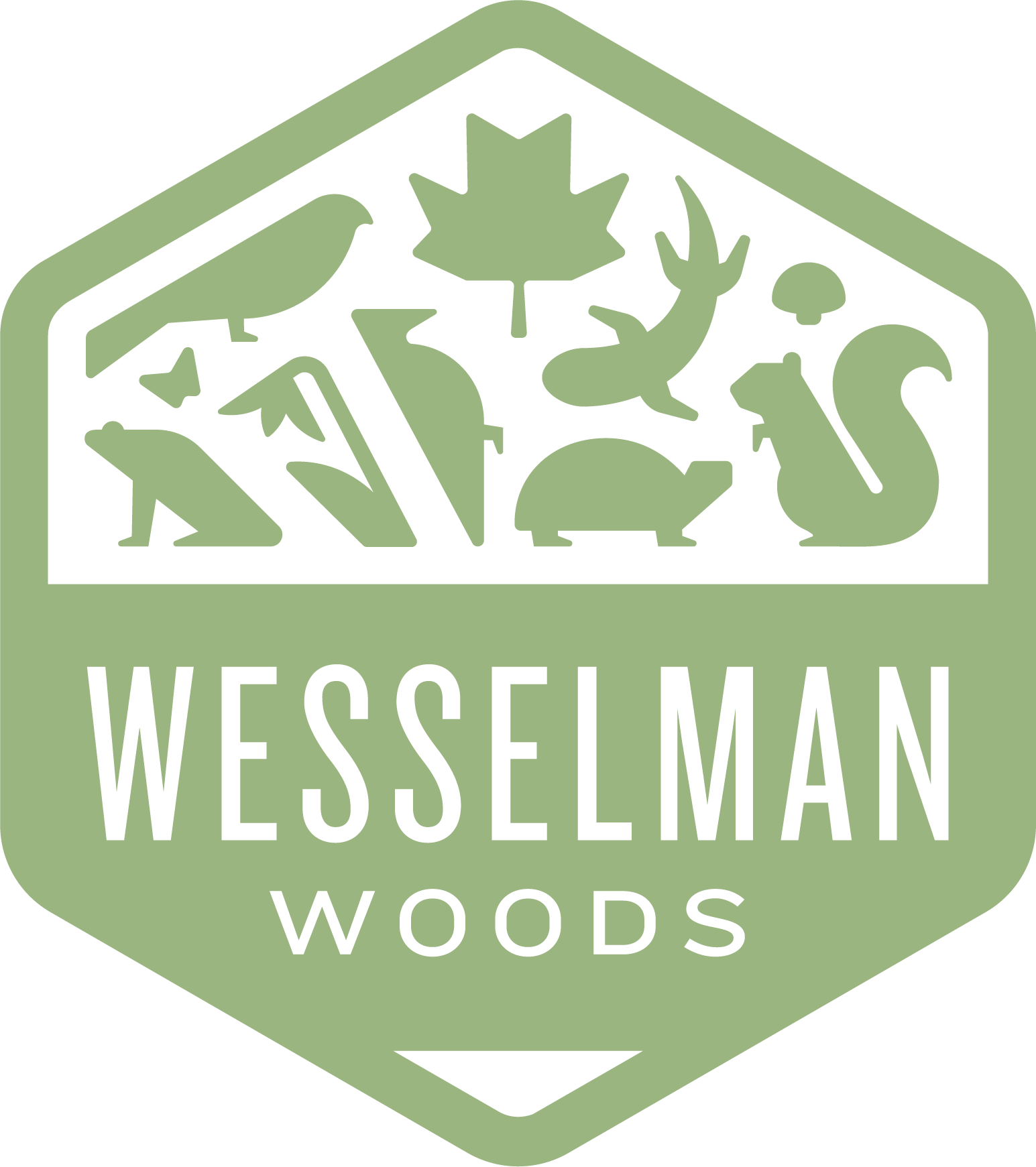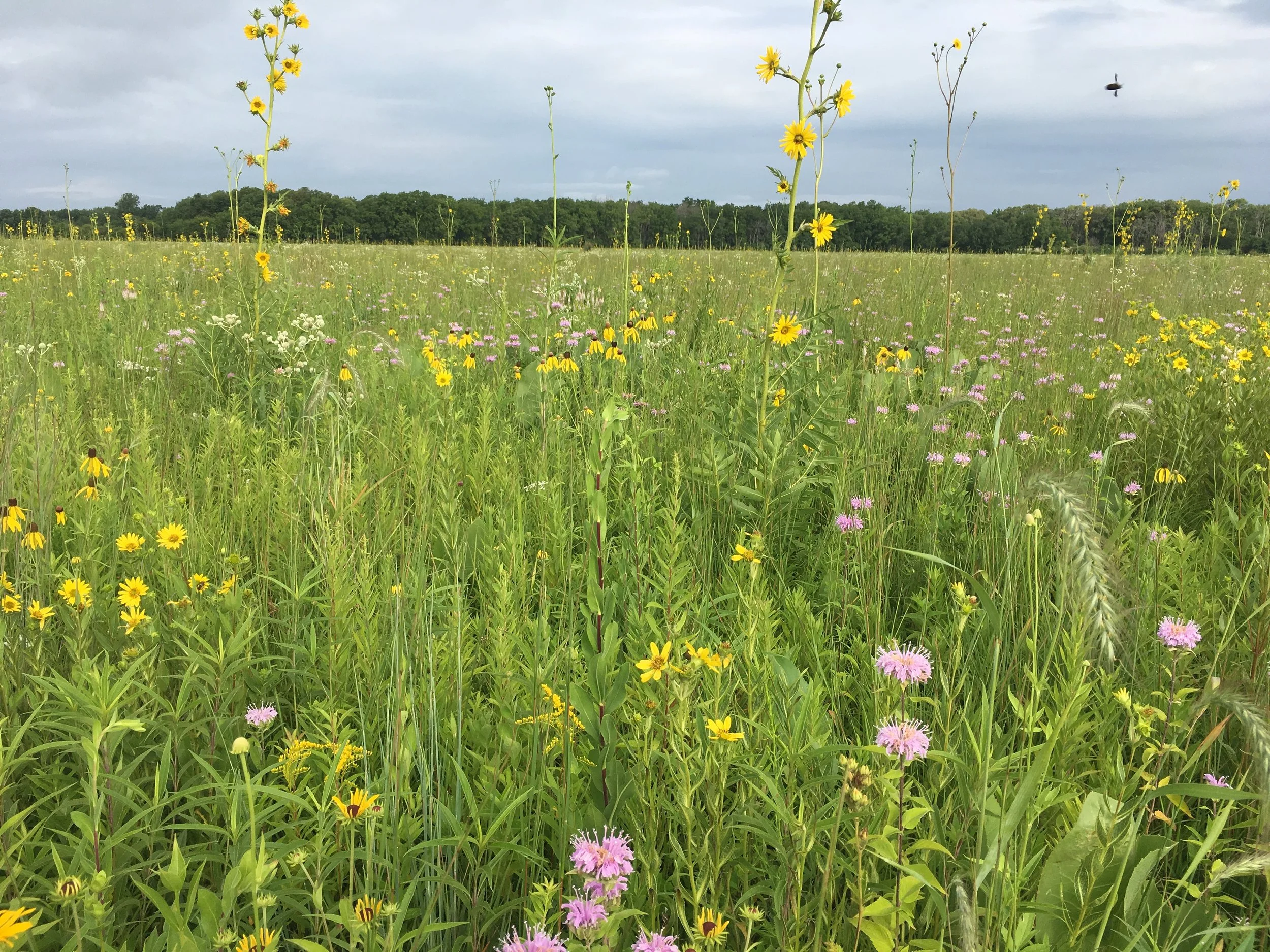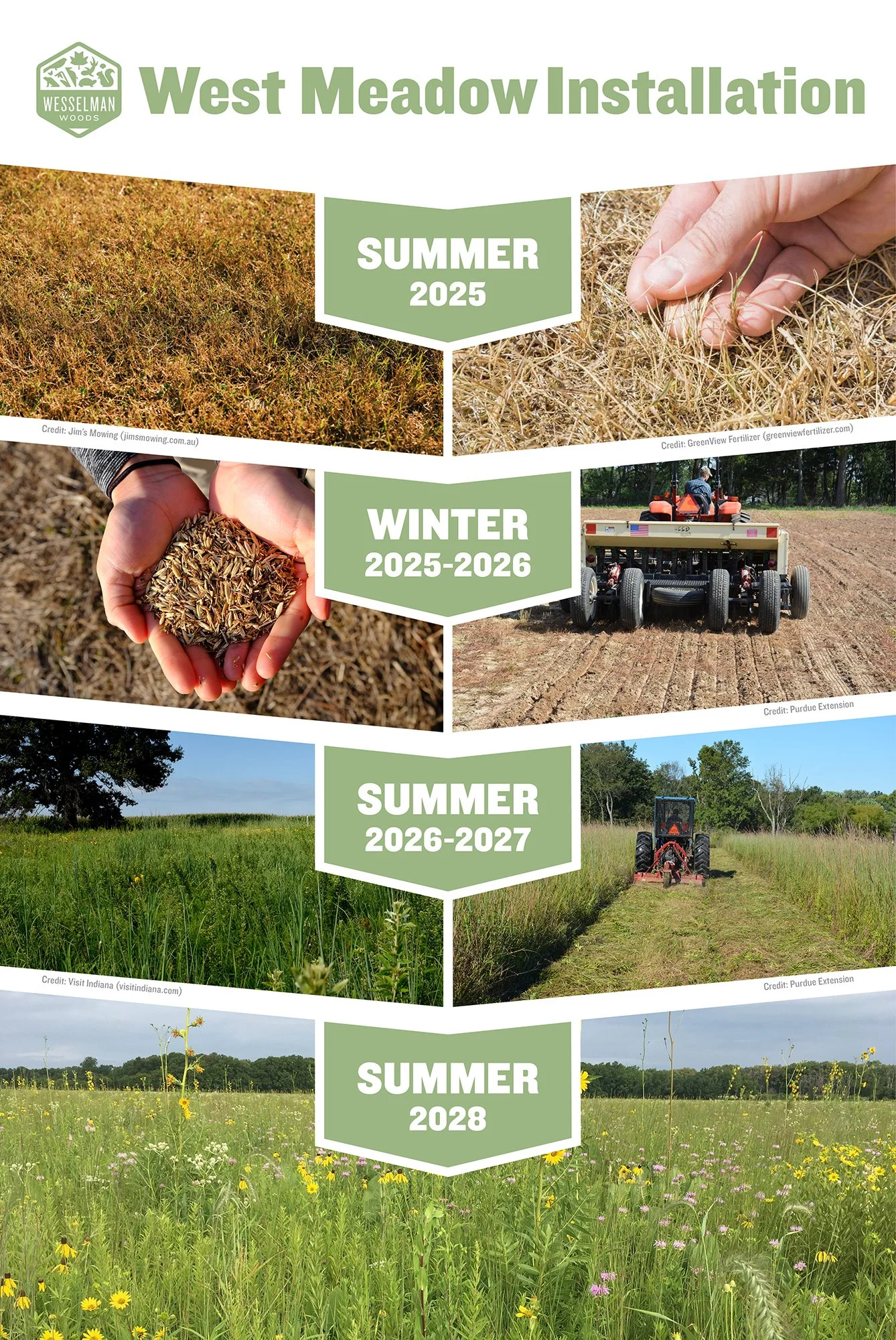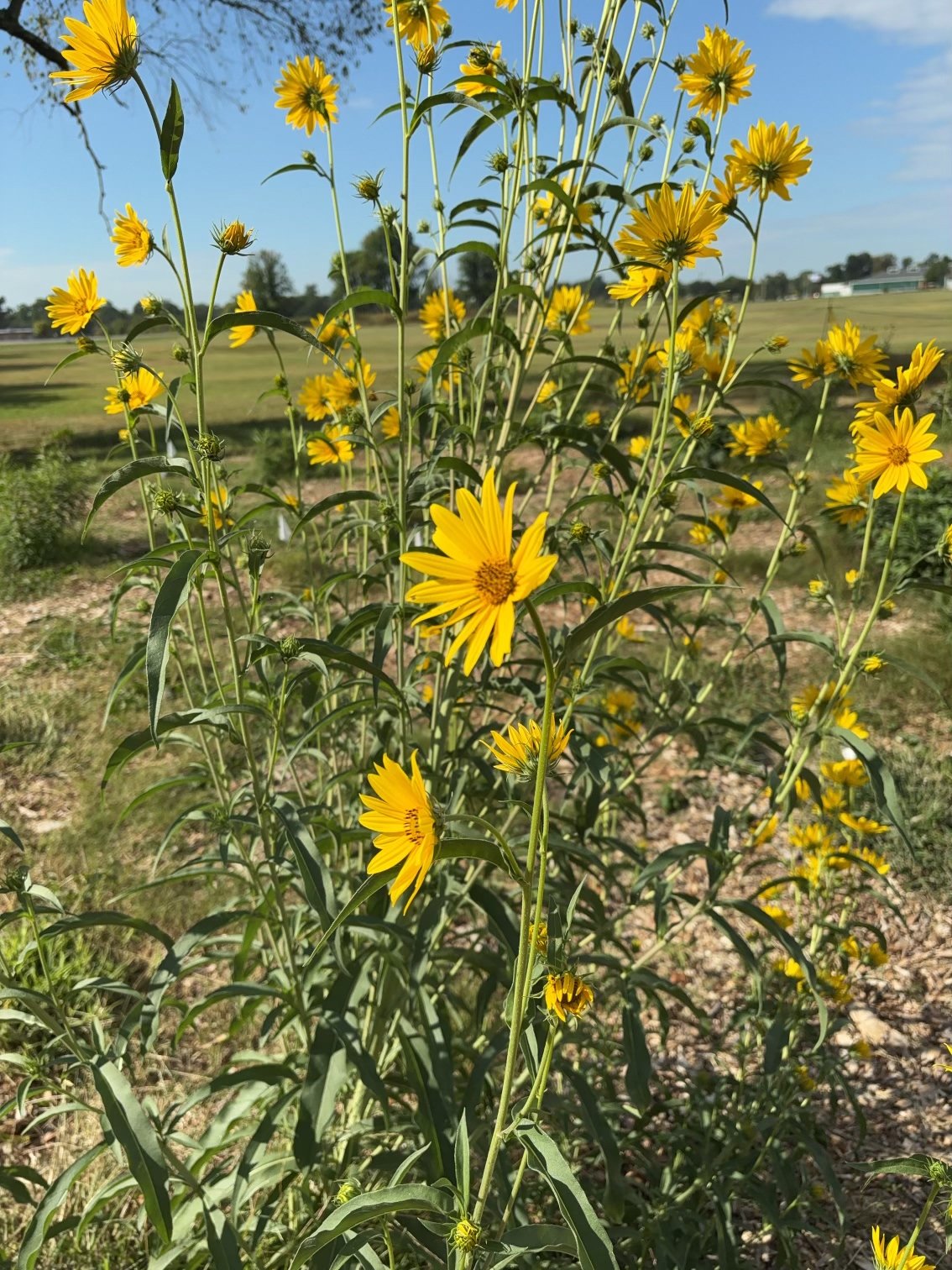West Meadow
Wesselman Woods is transforming the former par 3 golf course in Wesselman Park into a new habitat.
This installation of a low-stature native meadow is an exciting and meaningful step in our long-term vision to ecologically restore the 23-acres next to the nation’s largest old-growth forest. Our carefully planned meadow will not only add beauty, habitat, and trails, but it will also serve as an essential early phase in the natural process of ecological succession.
Once a manicured golf course (Par 3), the land will be on a journey from disturbance toward regeneration. The meadow mimics nature’s first response to open, disturbed ground—it initiates the way for soil health improvement, pollinator habitat creation, and increased native plant diversity. Over time, and with thoughtful stewardship, this landscape will continue its transformation toward a secondary forest, and eventually, we hope, into a thriving part of the old-growth ecosystem.
This will be more than planting a meadow—it's a promise to the land and future generations.
The process of installing a native meadow is one that requires patience. We are challenged to shift our human expectations for immediate results to nature’s slower pace. Join us in observing, tending, and enjoying the transformation of what has been an ecological desert into a habitat that will be rich with biodiversity.
First Steps
Summer to Fall 2025
A low-stature native pollinator seed mix will be installed on this 23-acre site in late 2025/early 2026. It is vital for the site to be cleared of aggressive-growing, invasive species in order for the native grasses and wildflowers to become established. To eradicate undesirable plants, three to four herbicide applications will be made over the 2025 growing season.
We want to assure the public that all necessary precautions will be taken to ensure the safety of people, wildlife, and the old-growth forest here at WW. The applicator will follow all applicable federal, state, and local regulations, including the strict guidelines set by the Office of the Indiana State Chemist. Application will occur under appropriate weather conditions to minimize drift, and all equipment will be operated and maintained to the highest professional standards.
Clear signage will be posted before, during, and after application to ensure awareness. We ask that the public avoid entering the treatment area during this time.
This short-term step is an essential part of a long-term ecological restoration plan that will support pollinators, improve soil and water quality, and establish a diverse, resilient native plant community.
We appreciate your understanding and support of this important restoration work.
NOTE: The pesticide section of Office of Indiana State Chemist (OISC) regulates the distribution and application of pesticides in the State of Indiana. The pesticide section is charged with the administration and enforcement of Indiana pesticide laws (I.C. 15-16-4 and I.C. 15-16-5) and also represents the U.S. Environmental Protection Agency (EPA) in Indiana for the purpose of enforcing many provisions of federal pesticide law.
The mission of the Office of Indiana State Chemist Pesticide Section is to protect the public and the environment by ensuring that pesticide products distributed within the state are properly formulated and labeled and that individuals who apply pesticides have met minimum competency standards, when required, and apply those pesticides without causing harm to people or property.
The licensed applicator assisting the West Meadow installation project meets all of the OISC standards and requirements for application.
Winter 2025-2026
We are fortunate to have the support of Pheasants Forever and Quail Forever (PFQF) on the West Meadow project! Quail Forever Local Chapter 3172 will contribute the use of a no-till seed drill and labor to install the native seed in the winter of 2025-2026. Many native plant species require cold-moist stratification in order to germinate. Sowing the seed in December or January will allow the seed time to go through the process and break dormancy in spring of 2026.
The native seed will be purchased from Spence Restoration Nursery (Muncie, IN), one of the premiere wholesale native plant and seed nurseries in the Midwest. Native species in the seed mix were selected for their ability to grow in full sun and withstand both dry and wet conditions.
What Are We Planting?
West Meadow Low-Stature Seed Mix
Allium cernuum (Nodding Wild Onion)
Aquilegia canadensis (Columbine)
Asclepias tuberosa (Butterflyweed)
Baptisia alba (White False Indigo)
Bouteloua curtipendula (Side-Oats Grama)
Carex brevior (Plains Oval Sedge)
Carex muehlenbergii (Sand Bracted Sedge)
Coreopsis lanceolata (Lance-Leaf Coreopsis)
Coreopsis palmata (Plains Coreopsis)
Dalea purpurea (Purple Prairie Clover)
Drymocallis arguta (Prairie Cinquefoil)
Echinacea purpurea (Purple Coneflower)
Eryngium yuccifolium (Rattlesnake Master)
Elymus canadensis (Canada Wild Rye)
Elymus virginicus (Virginia Wild Rye)
Helianthus mollis (Downy Sunflower)
Helianthus occidentalis (Western Sunflower)
Lespedeza capitata (Round-Headed Bush Clover)
Liatris aspera (Rough Blazing Star)
Liatris spicata (Prairie Blazing Star)
Monarda fistulosa (Bergamont)
Oligoneuron riddellii (Riddell’s Goldenrod)
Oligoneuron rigidum (Stiff Goldenrod)
Parthenium integrifolium (Wild Quinine)
Penstemon digitalis (Foxglove Beardtongue)
Penstemon hirsutus (Hairy Penstemon)
Pycnanthemum virginianum (Mountain Mint)
Ratibida pinnata (Yellow Coneflower)
Rudbeckia hirta (Black-Eyed Susan)
Schizachyrium scoparium (Little Bluestem)
Solidago nemoralis (Gray Goldenrod)
Solidago speciosa (Showy Goldenrod)
Sporobolus heterolepis (Prairie Dropseed)
Symphyotrichum ericoides (Heath Aster)
Symphyotrichum laeve (Smooth Aster)
Symphyotrichum oolentangiense (Sky-Blue Aster)
Tradescantia ohiensis (Ohio Spiderwort)
Veronicastrum virginicum (Culver’s Root)
What to Expect When You’re Expecting a Meadow
Year 1: 2026
After the native seed is sown, it is vital to give the emerging seedlings optimal growing conditions for successful recruitment and establishment. This requires discouraging aggressive growth by mowing the entire meadow when it reaches no more than 10-inches. Mowing down to 4 to 6 inches throughout the first growing season will keep annual non-native plant species from spreading seed and also allows more sunlight to reach the slower growing perennial native species just beginning to grow.
Year 2: 2027
Mowing once in the spring will help remove any remaining annual or biennial plant species coming up from the seed bank. The meadow should then be allowed to grow for the rest of the season unless there are areas of perennial non-natives such as sweet clover, Queen Ann’s Lace, Canada Thistle. Patches of these species will be mowed monthly, as needed.
Year 3: 2028
By the third year, the meadow should be established well enough that it will not need to be mowed. If areas of non-native species persist, they can be spot treated with selective herbicides.
Year 4 and Beyond
West Meadow will be considered mature by 2029, but will continue to evolve as the long-term plans for reforestation and the surrounding Wesselman Park are developed.
Community Collaboration
Wesselman Woods is partnering with several organizations to bring West Meadow to life, including:
Vanderburgh County SWCD
City of Evansville Parks and Recreation Department
Posey County Co-Op
Ancient Roots Native Nursery
Pheasants Forever, Inc. and Quail Forever
Bower-Suhrheinrich Foundation
University of Evansville ChangeLab
Frequently Asked Questions
-
We are working on eradicating the invasive turf grass on the golf course with 3-4 herbicide applications. This is to prepare the area for sowing native grass and wildflower seed in the winter of 2025.
-
Glyphosate, a widely used broad-spectrum herbicide accepted by the EPA to be harmless to humans and animals when used in accordance with its label.
Read the product label for Roundup PowerMax3 here.
The chemical mixture applied to the field will also include a drift agent (minimizes drift), a herbicide activator (surfactant that allows more chemical uptake into the plant making it more effective so less herbicide is needed), and a dye (to show areas that have been sprayed therefore less overlap and less herbicide used).
-
We want to assure the public that all necessary precautions will be taken to ensure the safety of people, wildlife, and the old-growth forest at Wesselman Woods.
The applicator will follow all applicable federal, state, and local regulations, including the strict guidelines set by the Office of the Indiana State Chemist.
Application will occur under appropriate weather conditions to minimize drift, and all equipment will be operated and maintained to the highest professional standards.
Clear signage will be posted before, during, and after application to ensure awareness. We ask that the public avoid entering the treatment area during this time.
-
A licensed applicator assisting the West Meadow installation project who meets all of the OISC (Office of the Indiana State Chemist) standards and requirements for the applications.
-
Herbicide applications: Wesselman Woods will conduct 3 to 4 herbicide applications between June to November of 2025.
The meadow will be established in 2027 and fully mature by 2028.
New-growth forest: Tree plantings will begin in fall 2025.
-
Wesselman Woods will begin planting trees in West Meadow in the fall of 2025.
-
Summer 2025: Eradicate turf grass with 3-4 herbicide applications
Winter 2025–26: Sow native seed using no-till drill during dormant season
Spring–Fall 2026: Mow to 4-6 inches to suppress weeds and support perennial growth
Spring & Fall 2027: Mow twice (May & November) to manage weed pressure
Summer 2028: Established meadow requires minimal maintenance; spot-treat invasive species as needed
-
This is partly funded by a $29,450 grant from the Vanderburgh County Soil and Water Conservation District.
The grant requires a 25% match, which Wesselman Woods will provide through financial and in-kind contributions, in collaboration with local partners.
The Bower-Suhrheinrich Foundation has also contributed to these ecological restoration efforts.
-
West Meadow is 23 acres.
-
The City of Evansville owns Wesselman Park, West Meadow, and Wesselman Woods Nature Preserve. The staff of Wesselman Woods steward the land of West Meadow and the Nature Preserve for the City.
-
Multiple organizations are collaborating on this project including Wesselman Woods, the City of Evansville Parks & Recreation Department, the Vanderburgh County Soil and Water Conservation District, Ancient Roots Native Nursery, Posey County Co-op, Pheasants Forever, Inc. and Quail Forever, and the University of Evansville ChangeLab.
-
Call Wesselman Woods at 812-479-0771 and ask for the Executive Director, Amy Rhodes.










